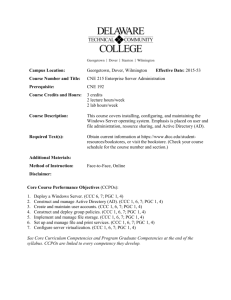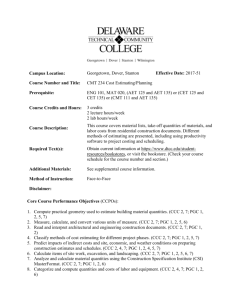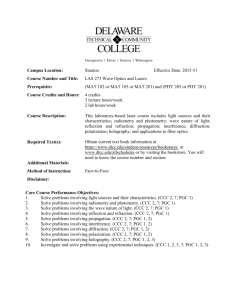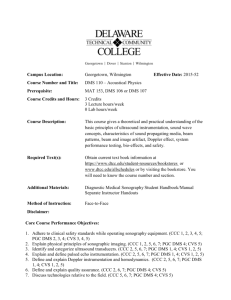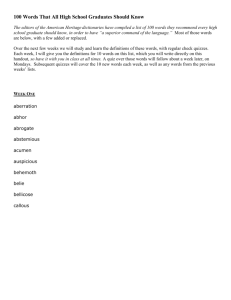Course Evaluation Measures Menu - E
advertisement
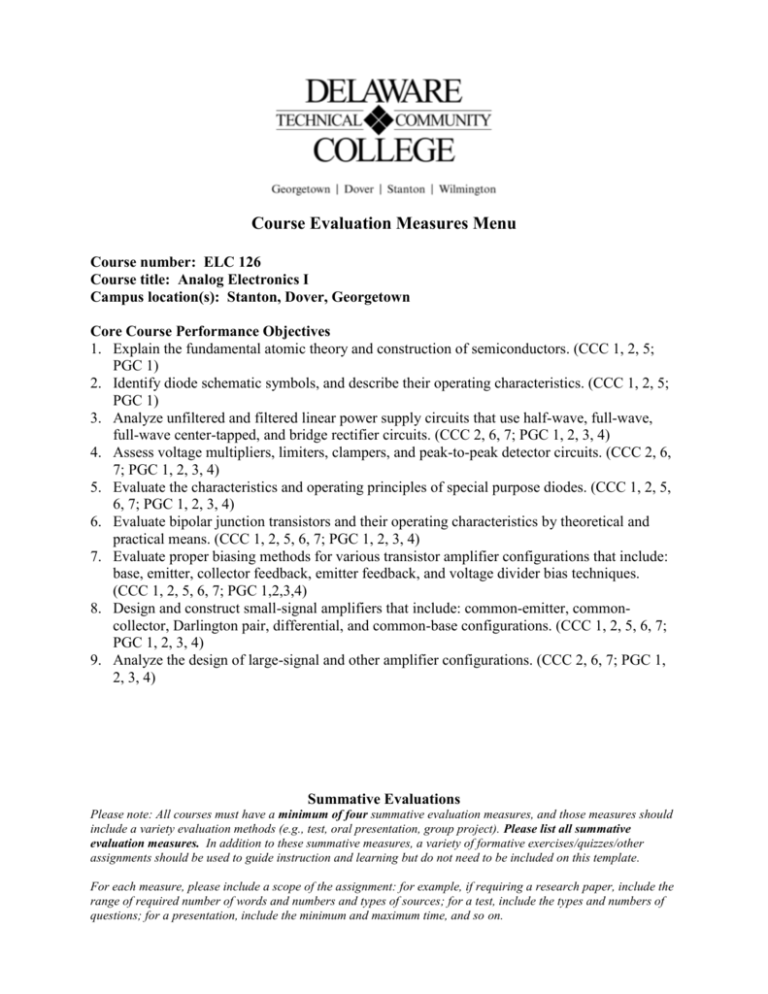
Course Evaluation Measures Menu Course number: ELC 126 Course title: Analog Electronics I Campus location(s): Stanton, Dover, Georgetown Core Course Performance Objectives 1. Explain the fundamental atomic theory and construction of semiconductors. (CCC 1, 2, 5; PGC 1) 2. Identify diode schematic symbols, and describe their operating characteristics. (CCC 1, 2, 5; PGC 1) 3. Analyze unfiltered and filtered linear power supply circuits that use half-wave, full-wave, full-wave center-tapped, and bridge rectifier circuits. (CCC 2, 6, 7; PGC 1, 2, 3, 4) 4. Assess voltage multipliers, limiters, clampers, and peak-to-peak detector circuits. (CCC 2, 6, 7; PGC 1, 2, 3, 4) 5. Evaluate the characteristics and operating principles of special purpose diodes. (CCC 1, 2, 5, 6, 7; PGC 1, 2, 3, 4) 6. Evaluate bipolar junction transistors and their operating characteristics by theoretical and practical means. (CCC 1, 2, 5, 6, 7; PGC 1, 2, 3, 4) 7. Evaluate proper biasing methods for various transistor amplifier configurations that include: base, emitter, collector feedback, emitter feedback, and voltage divider bias techniques. (CCC 1, 2, 5, 6, 7; PGC 1,2,3,4) 8. Design and construct small-signal amplifiers that include: common-emitter, commoncollector, Darlington pair, differential, and common-base configurations. (CCC 1, 2, 5, 6, 7; PGC 1, 2, 3, 4) 9. Analyze the design of large-signal and other amplifier configurations. (CCC 2, 6, 7; PGC 1, 2, 3, 4) Summative Evaluations Please note: All courses must have a minimum of four summative evaluation measures, and those measures should include a variety evaluation methods (e.g., test, oral presentation, group project). Please list all summative evaluation measures. In addition to these summative measures, a variety of formative exercises/quizzes/other assignments should be used to guide instruction and learning but do not need to be included on this template. For each measure, please include a scope of the assignment: for example, if requiring a research paper, include the range of required number of words and numbers and types of sources; for a test, include the types and numbers of questions; for a presentation, include the minimum and maximum time, and so on. CCPO Evaluation Measures: Include each agreed upon measure and scope of that measure (see above). 1. Explain the fundamental atomic theory and construction of semiconductors. (CCC 1, 2, 5; PGC 1) 2. Identify diode schematic symbols, and describe their operating characteristics. (CCC 1, 2, 5; PGC 1) 3. Analyze unfiltered and filtered linear power supply circuits that use half-wave, full-wave, full-wave center-tapped, and bridge rectifier circuits. (CCC 2, 6, 7; PGC 1, 2, 3, 4) 4. Assess voltage multipliers, limiters, clampers, and peak-to-peak detector circuits. (CCC 2, 6, 7; PGC 1, 2, 3, 4) 5. Evaluate the characteristics and operating principles of special purpose diodes. (CCC 1, 2, 5, 6, 7; PGC 1, 2, 3, 4) 6. Evaluate bipolar junction transistors and their operating characteristics by theoretical and practical means. (CCC 1, 2, 5, 6, 7; PGC 1, 2, 3, 4) 7. Evaluate proper biasing methods for various transistor amplifier configurations that include: base, emitter, collector feedback, emitter feedback, and voltage divider bias techniques. (CCC 1, 2, 5, 6, 7; PGC 1,2,3,4) Test #3: 30-50 questions including true/false, short answer, and problem solving Hands-on laboratories Homework / Pop Quizzes (points vary) Quizzes (points vary) 8. Design and construct small-signal amplifiers that include: common-emitter, common-collector, Darlington pair, differential, and common-base configurations. (CCC 1, 2, 5, 6, 7; PGC 1, 2, 3, 4) Hands-on laboratories 9. Analyze the design of large-signal and other amplifier configurations. (CCC 2, 6, 7; PGC 1, 2, 3, 4) Test #4: 30-50 questions including true/false, short answer, and problem solving Hands-on laboratories Homework / Pop Quizzes (points vary) Quizzes (points vary) Test #1: 30-50 questions including true/false, short answer, and problem solving Hands-on laboratories Homework / Pop Quizzes (points vary) Quizzes (points vary) Test #2: 30-50 questions including true/false, short answer, and problem solving Hands-on laboratories Homework / Pop Quizzes (points vary) Quizzes (points vary) FINAL COURSE GRADE (Calculated using the following weighted average) Evaluation Measure Percentage of final grade 3-4 Exams 50% 8-12 Laboratory Experiments 30% Homework/Pop Quizzes 10% Quizzes 10% TOTAL 100% LIST RELEVANT COURSE POLICIES (e.g., makeup policies for evaluation measures and learning experiences agreed upon collegewide) Quizzes versus pop quizzes: Quizzes are announced formative assessments that have a heavier weighting factor than pop quizzes, which serve to complement homework assignments and provide feedback on student progress toward mastery learning. Laboratory Experiments will include, but not limited to: building and testing AC/DC circuits that will include special purpose diodes and transistors. Students will analyze operational characteristics and behaviors of filtered and unfiltered rectifiers, and compare the calculated values with the measured values. (Electronic Signature Permitted) Submitted by (Collegewide Lead): __________________________________ Date __________________ Approved by counterparts Date ___________________ Reviewed by Curriculum Committee Date ___________________
